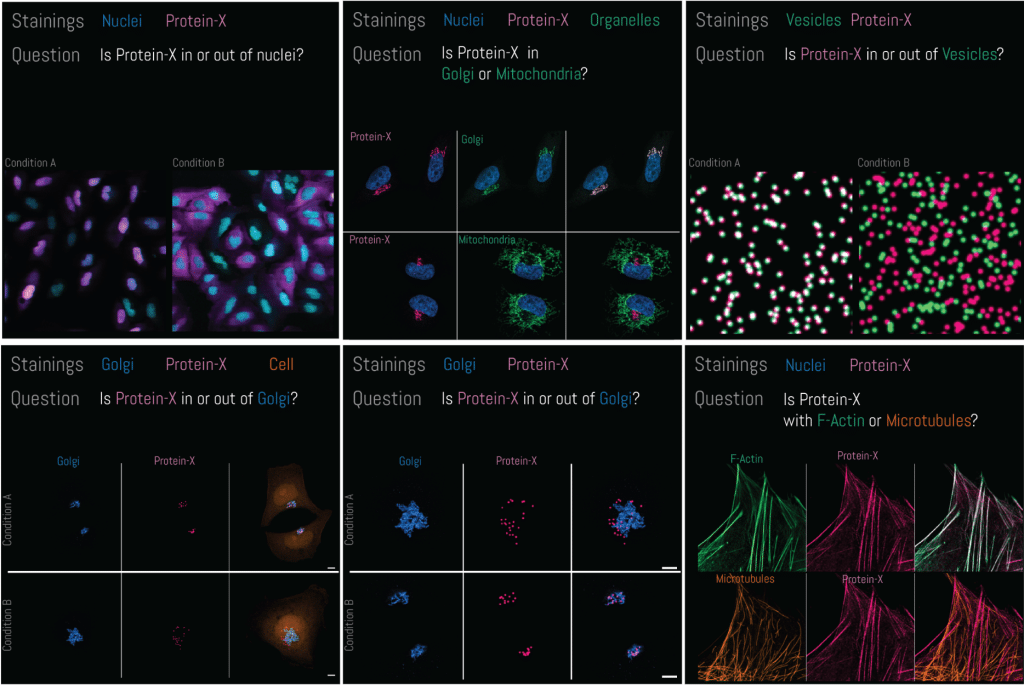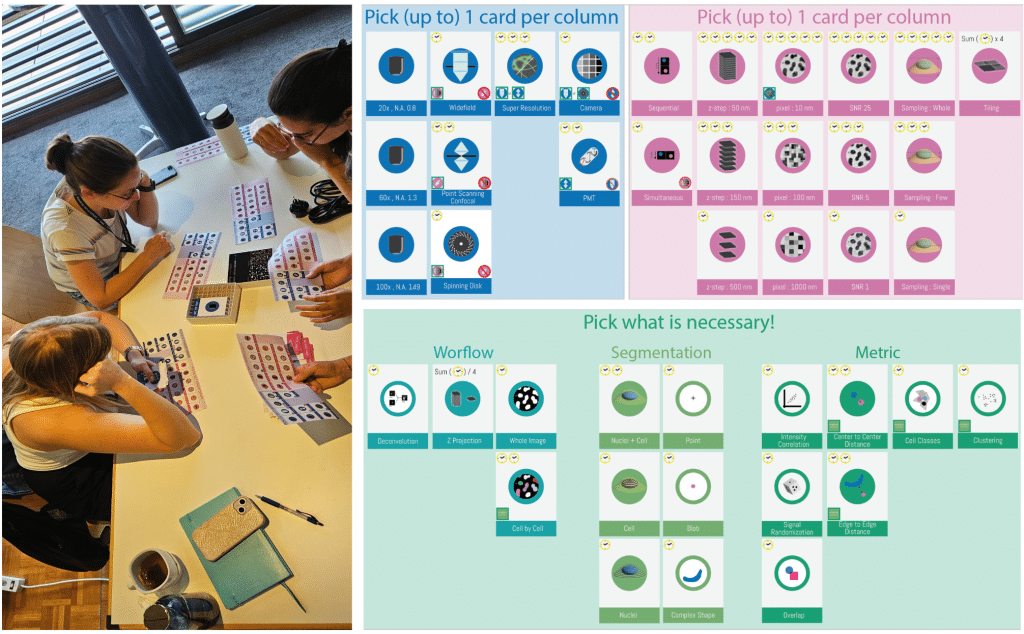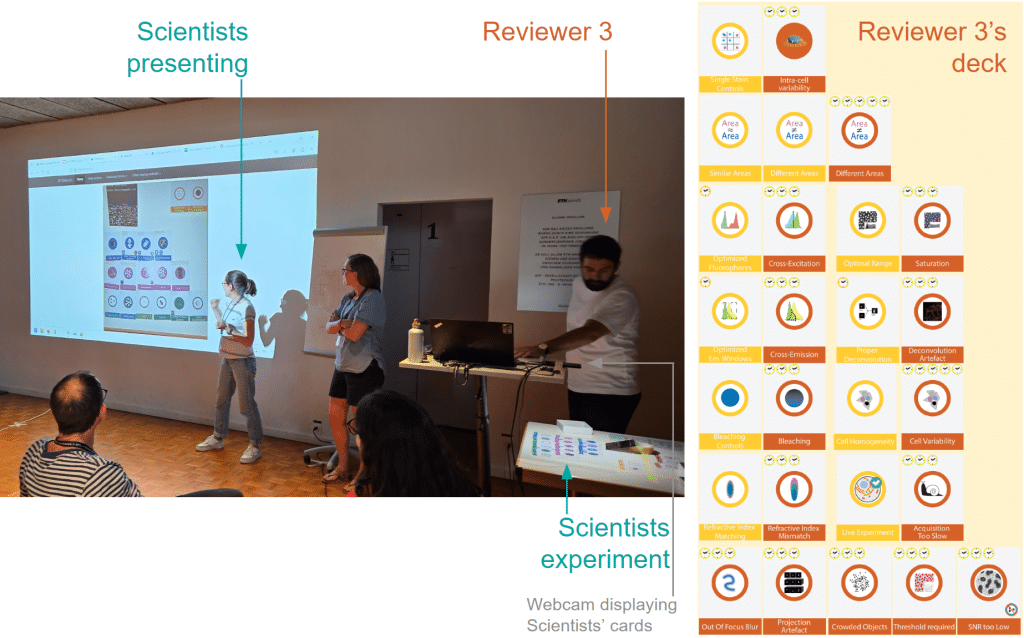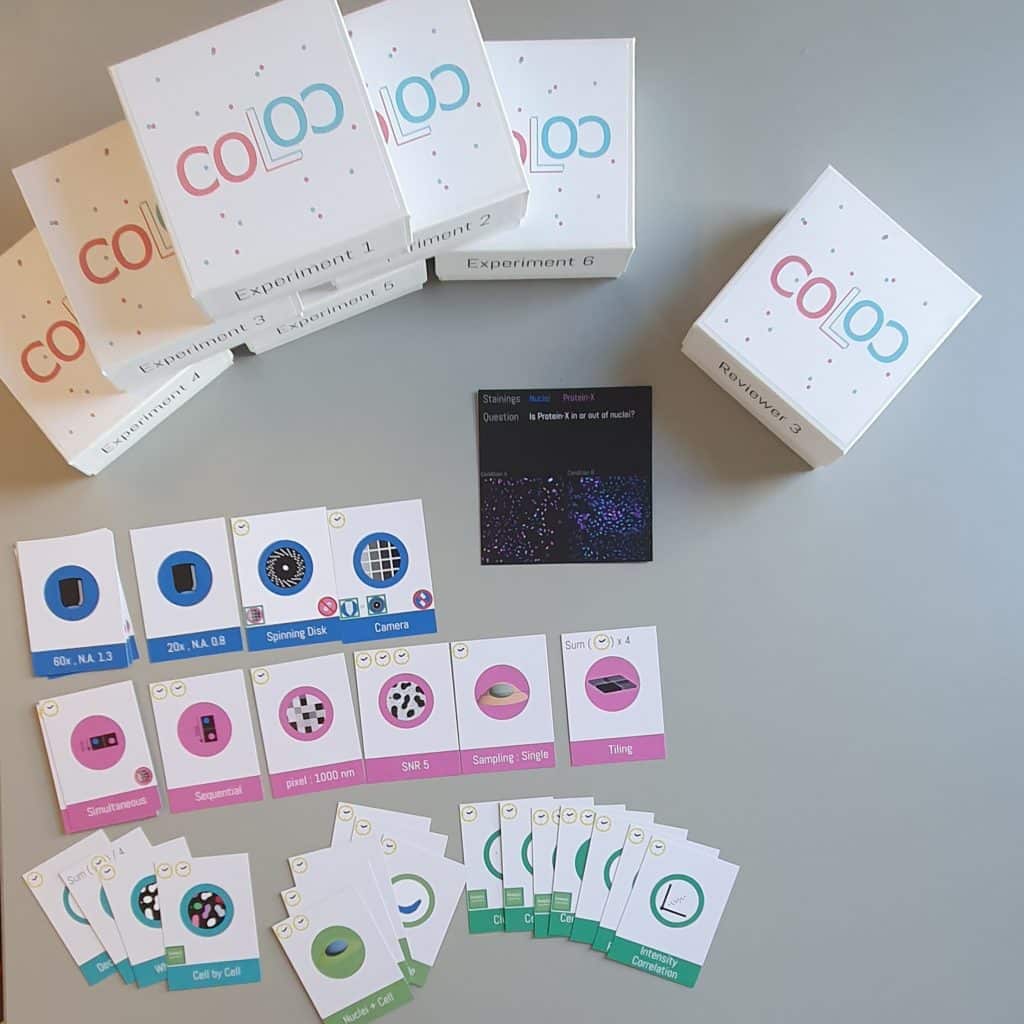Teaching co-localisation analysis from lecture to leisure
Posted by Romain Guiet, on 20 October 2024
The origin
There was one thing I was always skeptical about: colocalization analysis. When I started out as a BioImage Analyst, it was one of the first things I had to help users with in the BIOP at EPFL. I started learning more about it (and still continue to do so), tried with my own images so I could finally feel confident enough to train scientists and teach it to students. The culmination of these endeavors was a (too) long document with almost 200 slides that tried to keep things “simple” while remaining comprehensive without being exhausting [1]. Those slides contain theory, practical insights, many links to articles and step-by-step tutorials for the different tools we tested at the platform and recommend based on use cases. It became my teaching material to introduce co-localization concepts during our Image Processing and Analysis courses.
Then one day, during a brainstorming session, my supervisor Arne suggested making this course more practical. Our first thought was to turn the existing tutorials into hands-on exercises, but this would have taken too long for the students. I pitched to convert the slides into a board game and was happily surprised to be successful! That’s how I started the prototyping phase of what became: coLoↄ – The game!

Game design
A game designer friend I had collaborated with in the past taught me that the number one thing to think about when designing a game is: “What do you want the player to feel? Is it Joy? Anger? Fear? Frustration?”. With that in mind and with Olivier, my colleague and co-board game aficionado, we thought about the different game mechanics and dynamics we experienced – what we like and dis-like in games. This helped build a sort of wishlist for coLoↄ:
- Players should be slightly overwhelmed with the different possibilities of colocalization analysis
- The game should be oriented around solving a biologically relevant question using colocalization approaches
- The game should be collaborative, players will team up against the GameMaster
- The different teams must compete to “publish first”
- The interactions must create a friendly atmosphere while players discuss their choices
- A bit of stress and frustration should be present when presenting to the Game Master.
Solving a biologically relevant question
After defining the name of their team of Scientists, players also need to define a P.I. (Principal Investigator) and an Assistant that will be in charge of defending the work at the final stage. P.I.s from the different teams then come to the front of the room and randomly receive an experiment box containing an experiment card. Once they are back with their team, the first task will be to understand the co-localisation study they have to perform. It’s noteworthy that these examples are coming from real cases I encountered or little variation of them for educational purposes.

Overwhelm players, to make them conscious of the challenge, but not to the point that they would want to quit
Players have to define three characteristics of an experiment: Microscopy (objective, detectors…), Image (pixel size, z-step, …) and Analysis. For each component of the Microscopy and Image categories, players have to choose between two or three options. For the Analysis part, the choices are much more open and multiple combinations are valid. This was perfectly suited for existing as a deck of cards. There are over 42 cards. Regarding design I broke it into different colors representing the three components using icons from a pre-existing set and completing it to the needs of the game [2].
Each team has a single deck of cards, so I created supporting material so all the players of the same team could have an overview of the cards to discuss the experiment plan and which cards should be selected. These are the cheat-sheets with all the cards that are distributed at the start of the game.

Discussion and reaching a scientifically sound consensus is the core experience of the game. The cards and the possibilities that they offer lead to a lot of debate within a team, and learning from each other. It is the lesson itself. While that is happening, the Game Master is around to help keep the discussion going.
Trigger competition among players:
I wanted to trigger some competition (Science is competitive). Thus, we needed a scoring system to compare the performance of the teams. I also wanted to show how some steps in an experiment could be very time-consuming. These things together made me choose a clock as a marker. Second thought, being in Switzerland is maybe the third reason I was into clocks. So all the cards have from 0 to 5 clocks to represent how time-consuming this option will be.
But where would the fun be if everything was put into place to only help the players? We also add cards that seem like they add advantages but that will bias co-localization analysis. They exist to trigger a discussion with the players during the last step: the REVIEW. After players reach a consensus, they are called in front to present their experiment plan. This presentation will then be reviewed by the Game Master a.k.a. Reviewer 3.
Review process: Fears & Frustration at their best!
The review process is when the lesson really starts! Scientists are asked to present their experiment plan, explain their choices and defend them. Reviewer 3 will try their best to challenge and corner them using their dedicated deck of cards. This deck contains “Review” cards that can be used to ask for revisions or additional experiments (orange cards).
The scientists must verbally defend themselves which will lead Reviewer 3 to pick the corresponding “Answer” cards (yellow cards). Nevertheless, to validate each “Answer” card, scientists have to roll a dice and get a 5 or a 6. Validated cards cancel out the “Review” cards. Of course, in the case the dice has a value below 5, all cards stay and the clocks pile up!
This is a simple mechanism to engage in discussion about typical mistakes and pitfalls. Furthermore, this makes the following teams mention control experiments during the presentation.

Considering that Reviewer 3 has the burden (privilege) to keep the discussion going during the setup phase and has to challenge the players during the Review, I needed to create a Reviewer 3 Handbook, to help future Game Masters. The goal is to help them get into the mindset of the game, and understand what options they have to apply their knowledge of colocalization to animate a debate around a particular experiment.
Typical game time-line
We recently had our fifth game played (during ZIDAS 2024) and it went as follows :
| Step | Time, min. | Remarks |
| General Introduction by GM | 15 | Using slides, introduction to co-localization analysis |
| Create teams, find team name | 3 | Ask to define a “P.I.” and a “Ph.D”. or “Post-Doc” that will present the work at the end of the session. |
| Get the experiment box with card deck and cheat-sheets. Define microscopy and image parameters | 15 | First give 10 min (then ask if they need 5 more minutes to wrap up) |
| Define Analysis parameters | 15 | |
| Random decide of first team to present | 30 | Insist on the need of controls, invite them to use the “defense cards” |
| Second team | 15 | they mention controls ! |
| Third team | 10 | they mention controls ! |
| Fourth team | 10 | they mention controls ! |
| Conclusion | 5 | Look at the total of clocks and insist on the fact that they can’t really be compared because the experiments are way too different |
Download & Print or Order the game
Visit the website https://biop.github.io/coLoc/ to find links to Download & Print or Order the game!

[1] Guiet, R. (2024, March 22). A localization tale. Zenodo. https://doi.org/10.5281/zenodo.10854280
[2] https://github.com/lacan/microscopy-icons


 (4 votes, average: 1.00 out of 1)
(4 votes, average: 1.00 out of 1)
